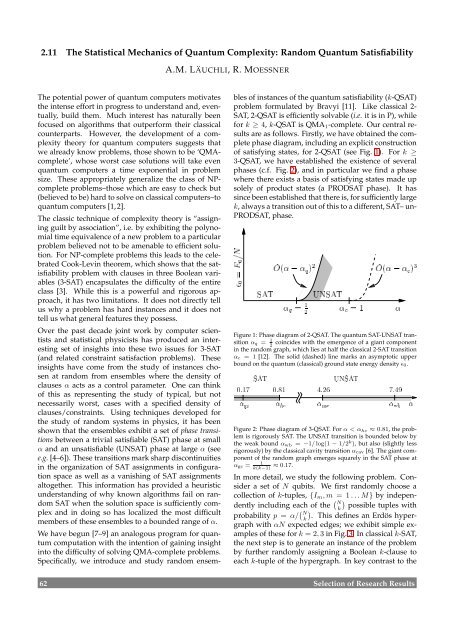Contents - Max-Planck-Institut für Physik komplexer Systeme
Contents - Max-Planck-Institut für Physik komplexer Systeme
Contents - Max-Planck-Institut für Physik komplexer Systeme
You also want an ePaper? Increase the reach of your titles
YUMPU automatically turns print PDFs into web optimized ePapers that Google loves.
2.11 The Statistical Mechanics of Quantum Complexity: Random Quantum Satisfiability<br />
The potential power of quantum computers motivates<br />
the intense effort in progress to understand and, eventually,<br />
build them. Much interest has naturally been<br />
focused on algorithms that outperform their classical<br />
counterparts. However, the development of a complexity<br />
theory for quantum computers suggests that<br />
we already know problems, those shown to be ‘QMAcomplete’,<br />
whose worst case solutions will take even<br />
quantum computers a time exponential in problem<br />
size. These appropriately generalize the class of NPcomplete<br />
problems–those which are easy to check but<br />
(believed to be) hard to solve on classical computers–to<br />
quantum computers [1, 2].<br />
The classic technique of complexity theory is “assigning<br />
guilt by association”, i.e. by exhibiting the polynomial<br />
time equivalence of a new problem to a particular<br />
problem believed not to be amenable to efficient solution.<br />
For NP-complete problems this leads to the celebrated<br />
Cook-Levin theorem, which shows that the satisfiability<br />
problem with clauses in three Boolean variables<br />
(3-SAT) encapsulates the difficulty of the entire<br />
class [3]. While this is a powerful and rigorous approach,<br />
it has two limitations. It does not directly tell<br />
us why a problem has hard instances and it does not<br />
tell us what general features they possess.<br />
Over the past decade joint work by computer scientists<br />
and statistical physicists has produced an interesting<br />
set of insights into these two issues for 3-SAT<br />
(and related constraint satisfaction problems). These<br />
insights have come from the study of instances chosen<br />
at random from ensembles where the density of<br />
clauses α acts as a control parameter. One can think<br />
of this as representing the study of typical, but not<br />
necessarily worst, cases with a specified density of<br />
clauses/constraints. Using techniques developed for<br />
the study of random systems in physics, it has been<br />
shown that the ensembles exhibit a set of phase transitions<br />
between a trivial satisfiable (SAT) phase at small<br />
α and an unsatisfiable (UNSAT) phase at large α (see<br />
e.g. [4–6]). These transitions mark sharp discontinuities<br />
in the organization of SAT assignments in configuration<br />
space as well as a vanishing of SAT assignments<br />
altogether. This information has provided a heuristic<br />
understanding of why known algorithms fail on random<br />
SAT when the solution space is sufficiently complex<br />
and in doing so has localized the most difficult<br />
members of these ensembles to a bounded range of α.<br />
We have begun [7–9] an analogous program for quantum<br />
computation with the intention of gaining insight<br />
into the difficulty of solving QMA-complete problems.<br />
Specifically, we introduce and study random ensem-<br />
A.M. LÄUCHLI, R. MOESSNER<br />
bles of instances of the quantum satisfiability (k-QSAT)<br />
problem formulated by Bravyi [11]. Like classical 2-<br />
SAT, 2-QSAT is efficiently solvable (i.e. it is in P), while<br />
for k ≥ 4, k-QSAT is QMA1-complete. Our central results<br />
are as follows. Firstly, we have obtained the complete<br />
phase diagram, including an explicit construction<br />
of satisfying states, for 2-QSAT (see Fig. 1). For k ≥<br />
3-QSAT, we have established the existence of several<br />
phases (c.f. Fig. 2), and in particular we find a phase<br />
where there exists a basis of satisfying states made up<br />
solely of product states (a PRODSAT phase). It has<br />
since been established that there is, for sufficiently large<br />
k, always a transition out of this to a different, SAT– un-<br />
PRODSAT, phase.<br />
Figure 1: Phase diagram of 2-QSAT. The quantum SAT-UNSAT transition<br />
αq = 1<br />
coincides with the emergence of a giant component<br />
2<br />
in the random graph, which lies at half the classical 2-SAT transition<br />
αc = 1 [12]. The solid (dashed) line marks an asymptotic upper<br />
bound on the quantum (classical) ground state energy density ǫ0.<br />
Figure 2: Phase diagram of 3-QSAT. For α < αhc ≈ 0.81, the problem<br />
is rigorously SAT. The UNSAT transition is bounded below by<br />
the weak bound αwb = −1/ log(1 − 1/2k ), but also (slightly less<br />
rigorously) by the classical cavity transition αcav [6]. The giant component<br />
of the random graph emerges squarely in the SAT phase at<br />
1<br />
αgc = ≈ 0.17.<br />
k(k−1)<br />
In more detail, we study the following problem. Consider<br />
a set of N qubits. We first randomly choose a<br />
collection of k-tuples, {Im,m = 1...M} by independently<br />
including each of the N<br />
k possible tuples with<br />
probability p = α/ N<br />
k . This defines an Erdös hypergraph<br />
with αN expected edges; we exhibit simple examples<br />
of these for k = 2,3 in Fig. 3. In classical k-SAT,<br />
the next step is to generate an instance of the problem<br />
by further randomly assigning a Boolean k-clause to<br />
each k-tuple of the hypergraph. In key contrast to the<br />
62 Selection of Research Results
















